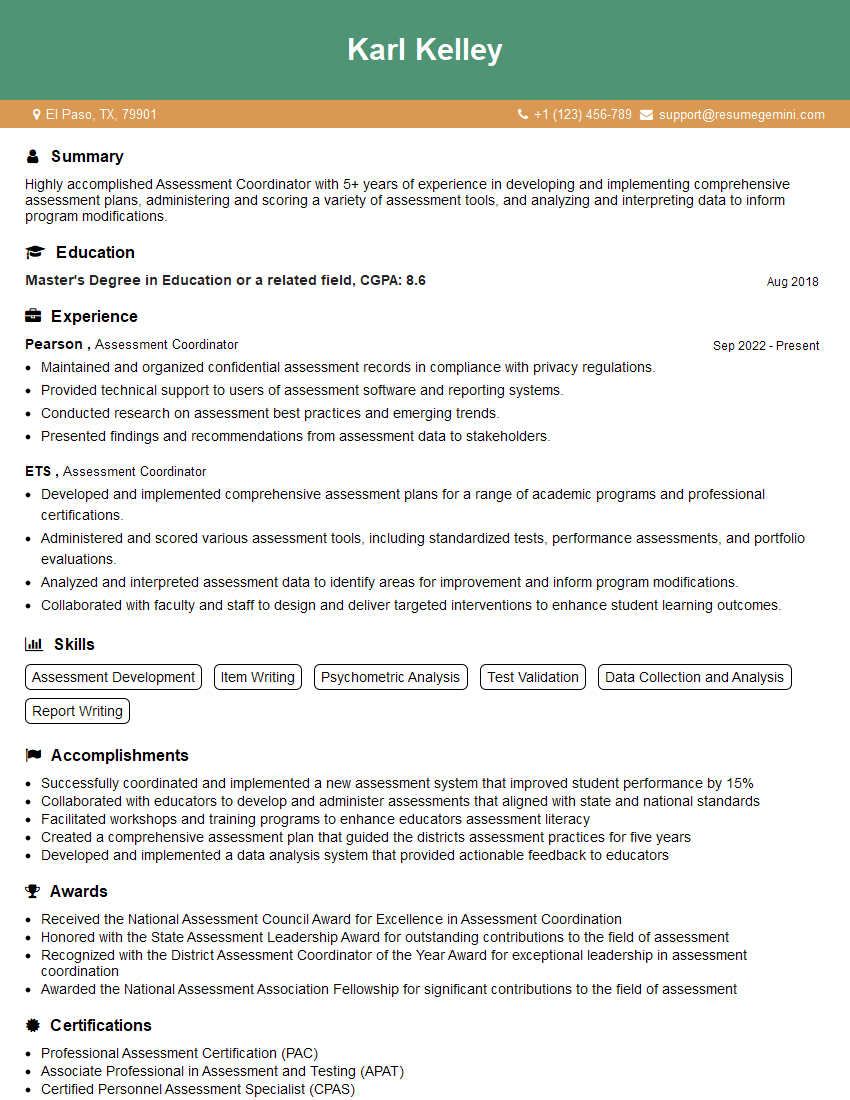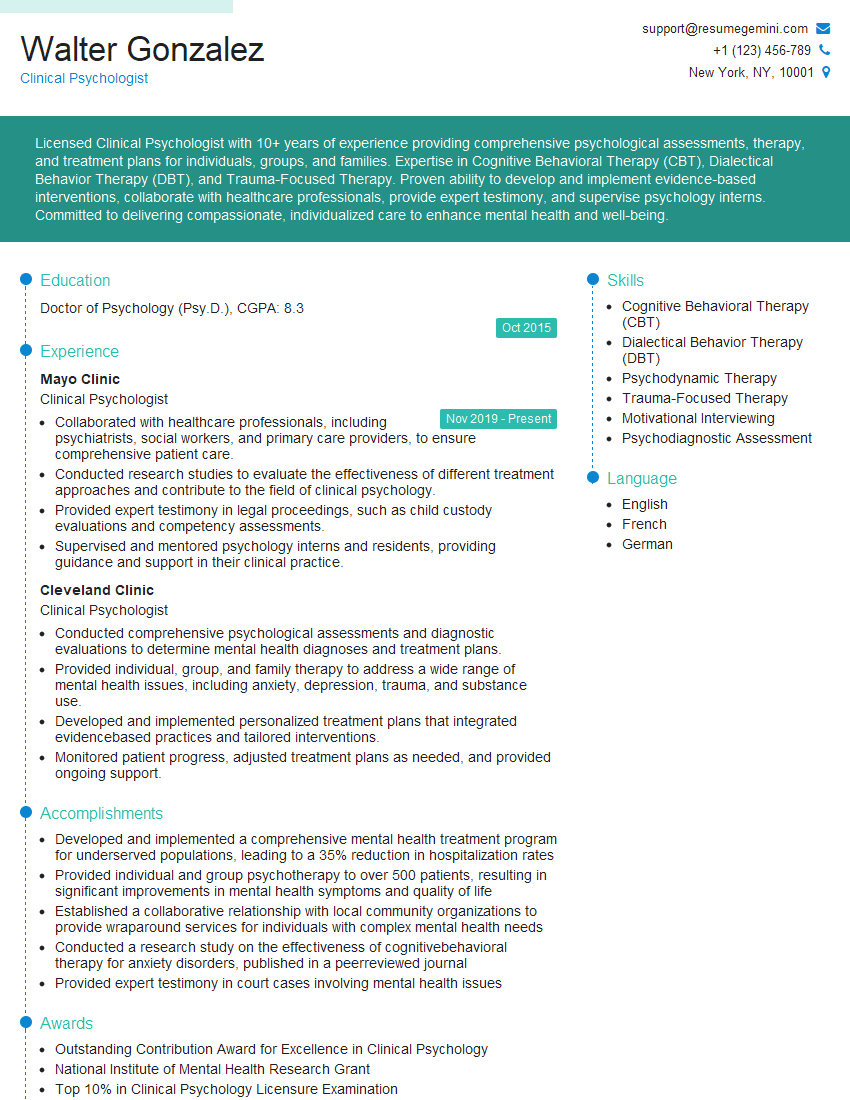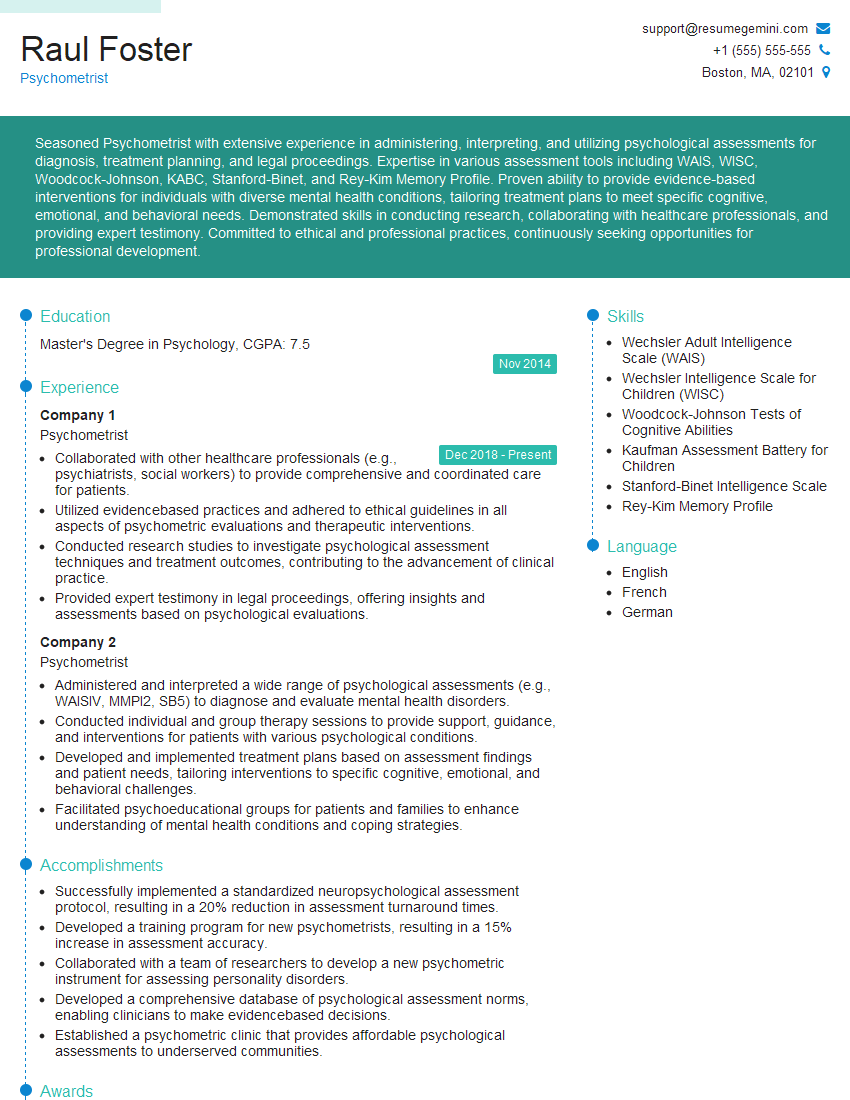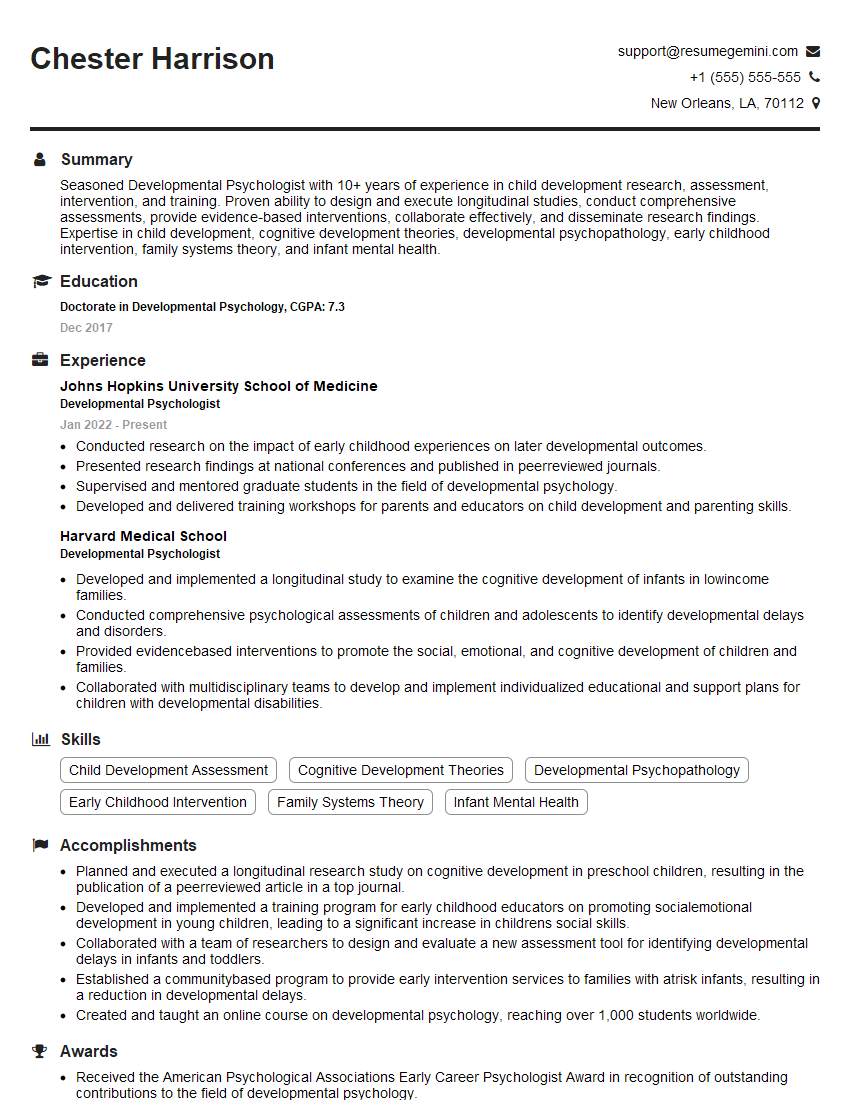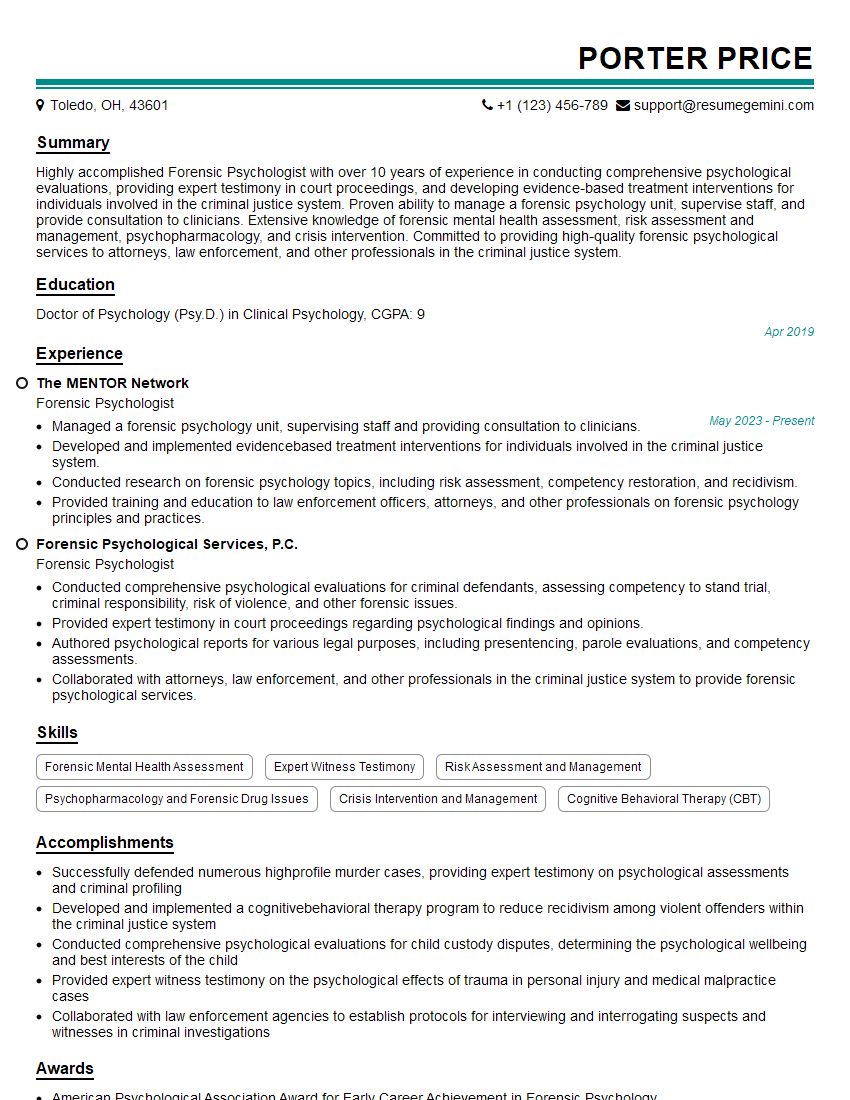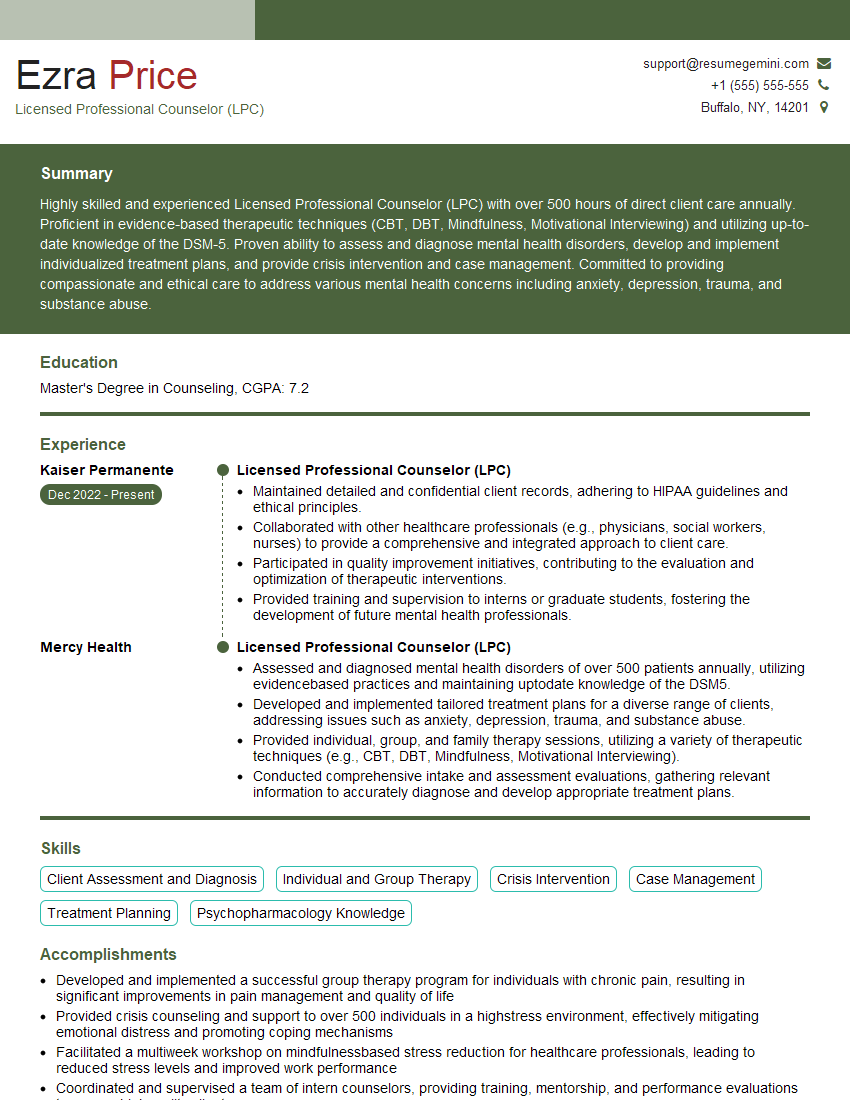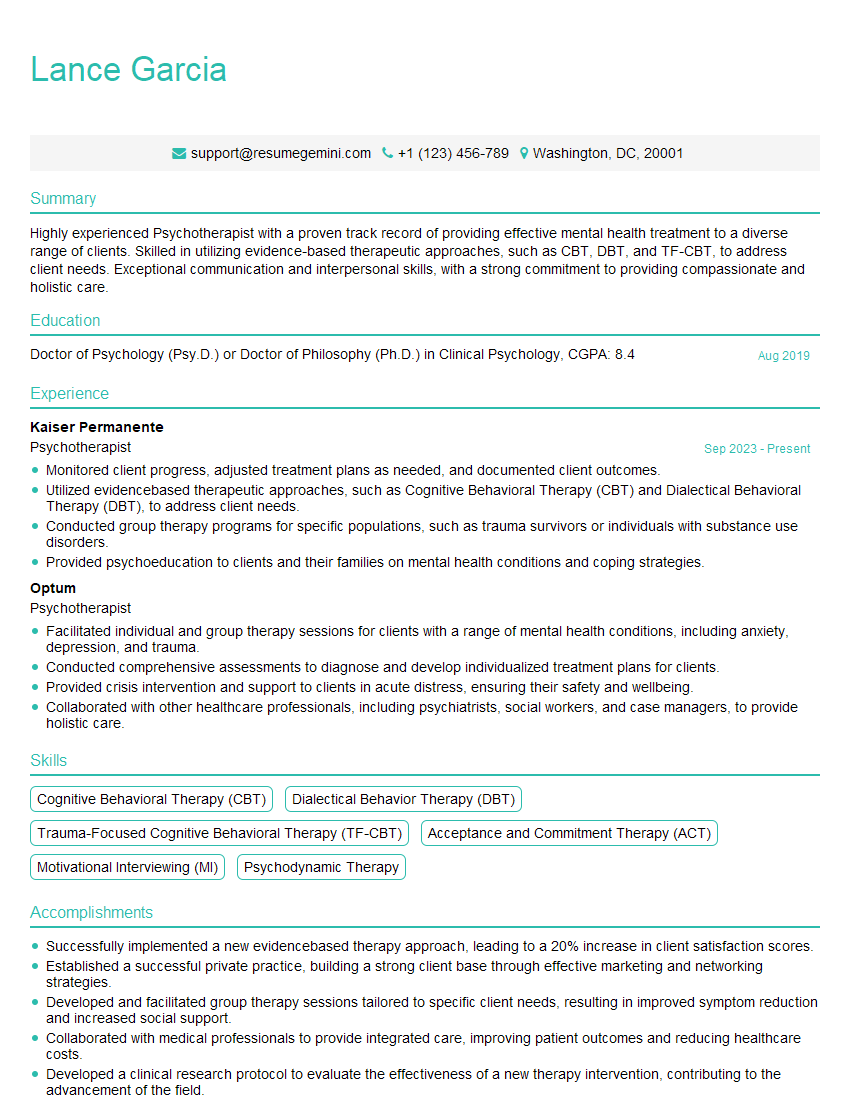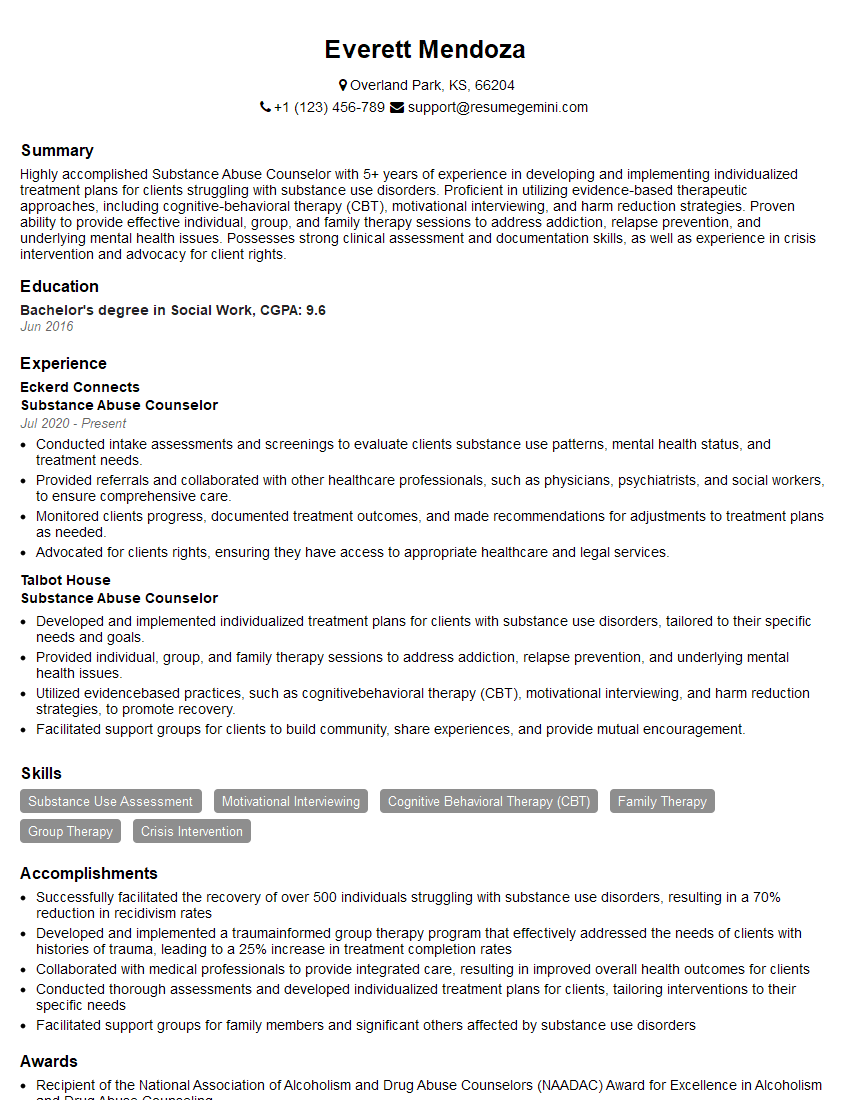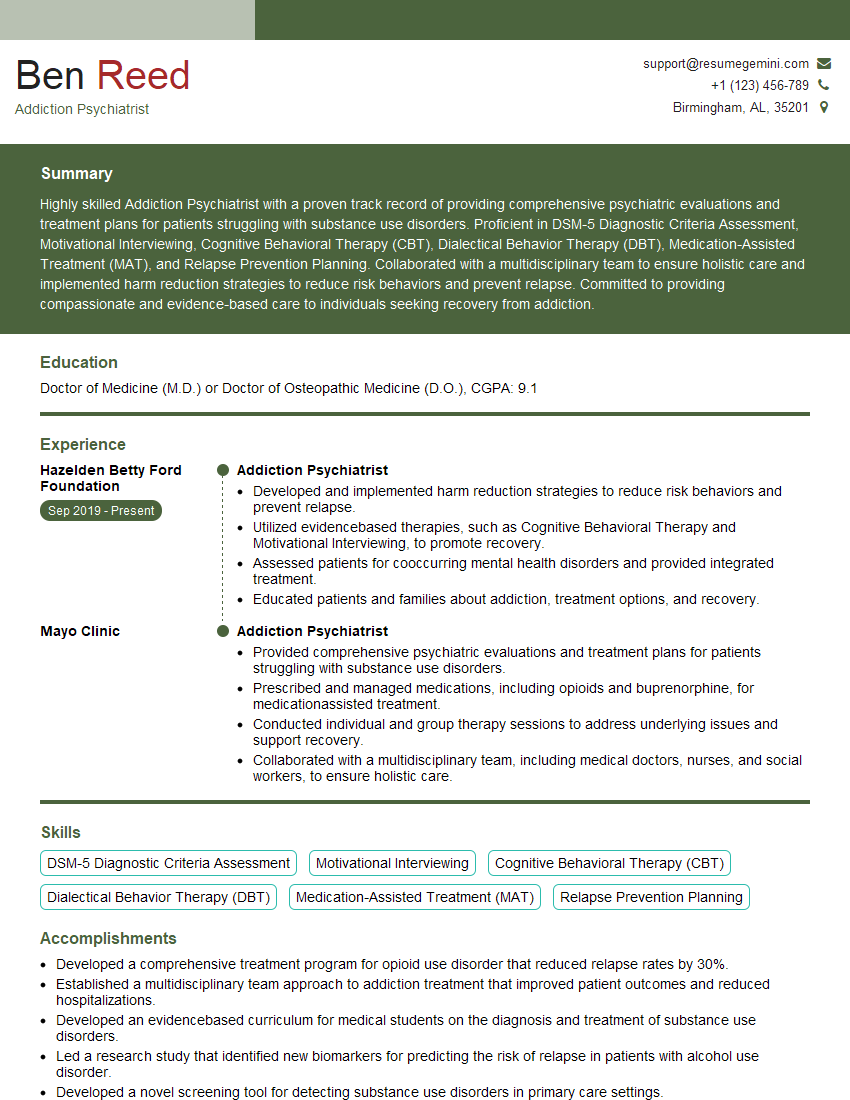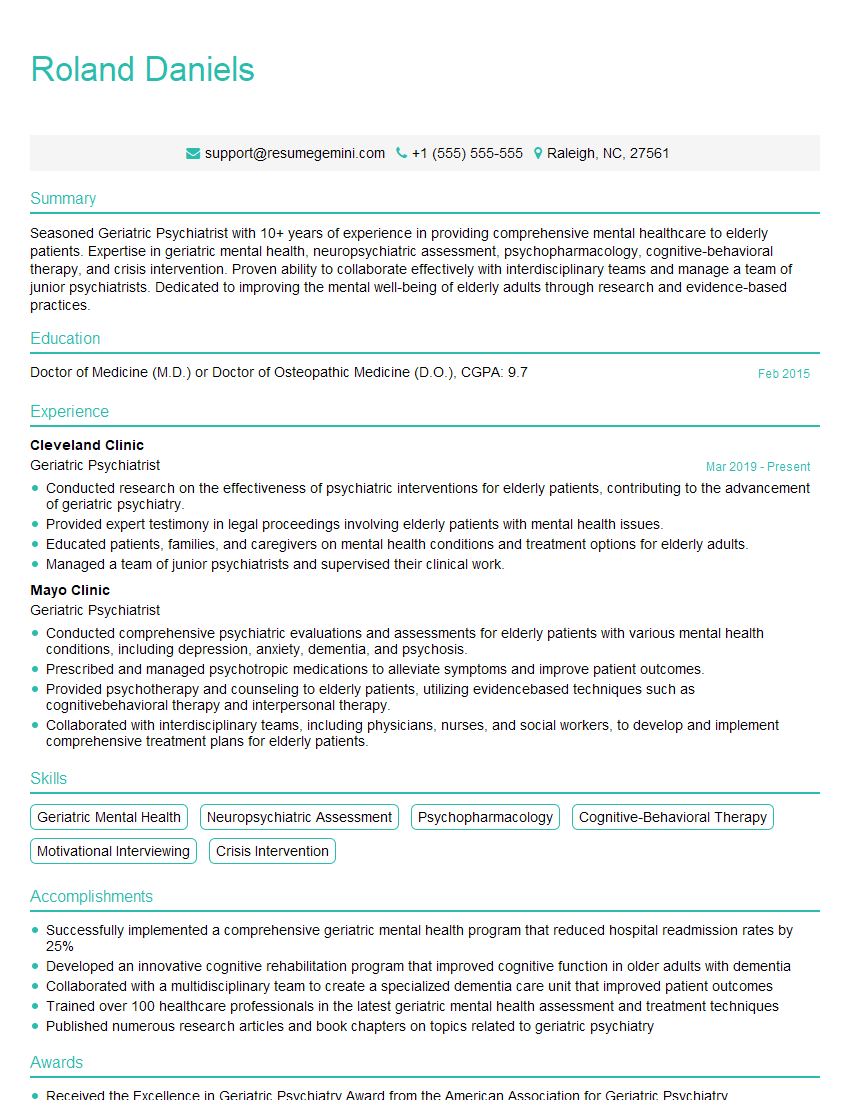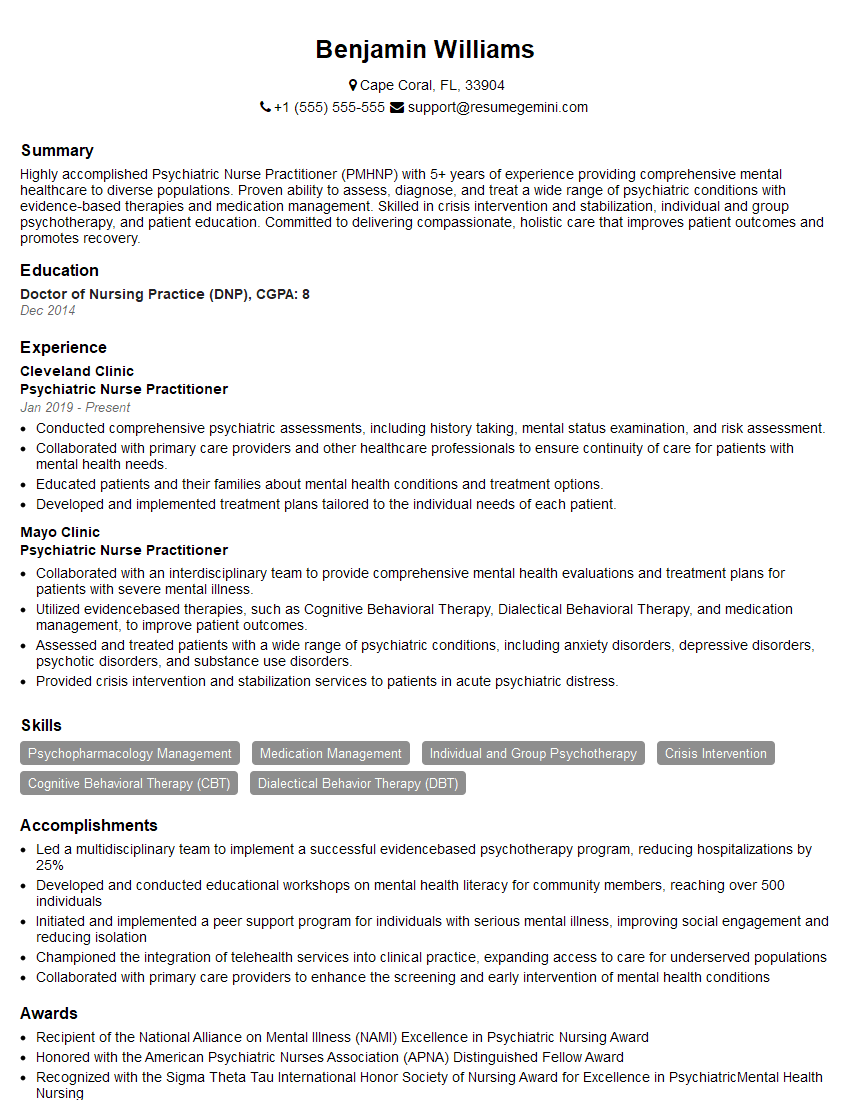The thought of an interview can be nerve-wracking, but the right preparation can make all the difference. Explore this comprehensive guide to Therapeutic Assessment interview questions and gain the confidence you need to showcase your abilities and secure the role.
Questions Asked in Therapeutic Assessment Interview
Q 1. Explain the difference between a projective and objective assessment tool.
The core difference between projective and objective assessment tools lies in how they elicit and interpret information about a client’s personality, thoughts, and feelings. Objective tests use standardized questions with limited response options, focusing on quantifiable data. Think of a multiple-choice exam – the scoring is clear-cut. Examples include the Minnesota Multiphasic Personality Inventory (MMPI-2) and various intelligence tests like the Wechsler scales. These tests aim for objectivity in scoring and interpretation, reducing subjectivity.
Projective tests, conversely, present ambiguous stimuli – like inkblots (Rorschach) or incomplete sentences (Sentence Completion tests) – and invite open-ended responses. The idea is that the client projects their unconscious thoughts and feelings onto the ambiguous stimuli, revealing underlying personality dynamics. Interpretation is more subjective and relies heavily on the clinician’s expertise and experience. The lack of standardization makes the scoring process less objective. For example, two clinicians might interpret a response to an inkblot differently.
In essence, objective tests prioritize structured measurement, while projective tests focus on exploring unconscious processes. The choice depends on the specific assessment goals and the clinician’s theoretical orientation.
Q 2. Describe your experience administering the Wechsler Adult Intelligence Scale (WAIS).
I have extensive experience administering the Wechsler Adult Intelligence Scale (WAIS), having administered it to hundreds of clients across diverse backgrounds and age ranges. My process involves careful adherence to standardized administration protocols. This includes establishing rapport with the client, ensuring they understand the instructions, meticulously timing each subtest, and carefully observing their responses.
Beyond the technical aspects, I prioritize creating a comfortable and supportive testing environment to minimize test anxiety and encourage optimal performance. This involves explaining the purpose of the assessment in a way the client can understand, offering encouragement and positive reinforcement throughout the process, and addressing any concerns or questions they may have.
After the administration, I meticulously score the subtests and generate a comprehensive report that includes verbal comprehension, perceptual reasoning, working memory, and processing speed indices, as well as a full-scale IQ score. I then interpret these scores within the context of the client’s background, presenting my findings in a clear and accessible manner. For instance, I might explain how a low score in working memory could impact daily life tasks or discuss strengths and weaknesses in cognitive profiles.
Q 3. What are the limitations of using the Minnesota Multiphasic Personality Inventory (MMPI-2) ?
While the MMPI-2 is a powerful tool, it’s crucial to acknowledge its limitations. One major limitation is its reliance on self-report. Clients might be influenced by factors like social desirability bias, where they answer questions in a way they think will be viewed favorably. Similarly, response sets, such as acquiescence (agreeing with everything) or defensiveness, can distort the results.
Another limitation stems from its potential for cultural bias. The norms were primarily based on white, middle-class individuals, meaning scores for individuals from different cultural backgrounds might not be accurately interpreted. Clinicians must be particularly cautious when interpreting MMPI-2 results from individuals with limited English proficiency or from cultures with significantly different communication styles.
Furthermore, the MMPI-2, like any psychological test, should not be interpreted in isolation. It is vital to integrate findings from other assessment methods, including clinical interviews and behavioral observations, to create a holistic understanding of the individual. Over-reliance on the MMPI-2 without considering other factors could lead to misdiagnosis or inappropriate treatment recommendations.
Q 4. How do you interpret results from the Beck Depression Inventory (BDI-II)?
The Beck Depression Inventory-II (BDI-II) is a self-report measure assessing the severity of depressive symptoms. Interpretation involves examining the total score, considering the specific items endorsed, and contextualizing these findings with other clinical information.
A higher total score indicates greater symptom severity. The BDI-II provides a range of severity levels, from minimal to severe depression. It’s crucial, however, not to rely solely on the numerical score. For example, a client scoring in the moderate range might endorse several items related to suicidal ideation, which would require immediate attention regardless of the overall score.
It’s equally important to consider the specific items the client endorsed. If a client scores moderately high but only on items related to fatigue and appetite changes, the clinical picture differs significantly from a client with the same total score but also endorsing feelings of worthlessness and suicidal thoughts.
Finally, integration with other clinical data – such as the client’s history, current stressors, and observed behavior – is critical for a complete understanding. The BDI-II provides valuable information but should not be the sole basis for diagnosis or treatment planning.
Q 5. Discuss the ethical considerations in administering and interpreting psychological tests.
Ethical considerations are paramount in psychological assessment. They guide every stage, from test selection to report writing. Confidentiality is a cornerstone, meaning client information must be protected and only shared with those who have a legitimate need to know and with the client’s informed consent.
Informed consent is vital. Clients must understand the purpose, procedures, and potential implications of the assessment before agreeing to participate. They need to know how the information will be used and who will have access to it.
Competence is essential. Clinicians should only use tests for which they have adequate training and experience. Misinterpreting results can have severe consequences. Using outdated or unreliable tests is equally unethical.
Cultural sensitivity is a critical aspect. Clinicians must consider how cultural factors might influence test performance and interpretation. Avoid using tests that are biased toward specific cultural groups, and be aware of cultural differences that could affect the interpretation of findings.
Test security must be maintained. Leaking test content compromises the validity and reliability of the assessment.
Finally, clinicians have an ethical obligation to provide clients with feedback and interpret results in a way they can understand and apply to their lives. The whole process must be conducted with integrity, respect, and a commitment to the client’s well-being.
Q 6. Explain your approach to integrating assessment data from multiple sources.
Integrating data from multiple sources is fundamental to comprehensive assessment. My approach involves a systematic process that emphasizes triangulation – confirming information from several sources. I start by organizing the data from different assessment methods, including clinical interviews, self-report measures, behavioral observations, and collateral information (from family, friends, or other professionals).
Then, I look for patterns and inconsistencies. Agreement across different sources strengthens confidence in the findings, while discrepancies prompt further investigation. For example, if a self-report measure indicates high anxiety, but the client presents calmly during the interview, I explore the potential reasons for this discrepancy, perhaps considering response biases or other influencing factors.
I use a narrative approach, weaving together the data into a cohesive picture of the individual’s strengths, challenges, and clinical presentation. This narrative should be detailed, incorporating relevant background information and making clear connections between assessment findings and clinical formulation.
Finally, I discuss my findings with the client, using language they can understand and emphasizing their involvement in the treatment planning process. The integrated assessment provides a rich and nuanced understanding, leading to more effective and individualized interventions.
Q 7. How do you ensure cultural sensitivity in your assessment practices?
Cultural sensitivity is crucial for ethical and effective assessment. It begins with self-reflection on my own biases and assumptions. I recognize that my own cultural background shapes my perceptions and interpretations, and I strive for continuous learning and awareness of different cultural perspectives.
I select assessment tools that are culturally appropriate and have been validated with diverse populations. I avoid using instruments known to be biased against specific cultural groups. Where necessary, I use translated versions of tests that have been carefully adapted to account for linguistic and cultural nuances.
During the assessment process, I adapt my communication style to be culturally sensitive. This might involve using interpreters, adjusting my language to be more accessible, or being mindful of nonverbal communication differences. I also actively seek information about the client’s cultural background and experiences, understanding how these factors could influence their responses and behavior.
Finally, I interpret the results cautiously, considering potential cultural influences on test performance. I avoid making generalizations based on cultural stereotypes and instead focus on the individual client’s unique characteristics and circumstances. I also ensure that the feedback and recommendations are culturally appropriate and relevant to the client’s life context.
Q 8. Describe a situation where you had to adapt your assessment approach due to client factors.
Adapting my assessment approach is crucial for ensuring accurate and meaningful results. Client factors such as age, cultural background, language proficiency, cognitive abilities, and sensory impairments can significantly impact their ability to engage with standard assessment tools. For instance, I once worked with a young child diagnosed with autism spectrum disorder who struggled with maintaining attention during traditional cognitive testing. To accommodate this, I adapted the assessment by shortening test sessions, incorporating visual aids, and using a playful, interactive approach. This allowed me to gather valuable information while respecting the child’s developmental stage and unique needs. In another case, a client with limited English proficiency required the use of a translator and culturally appropriate assessment materials. This emphasized the importance of considering cultural context when selecting and administering assessments. Ultimately, successful adaptation hinges on flexibility, creativity, and a deep understanding of the client’s individual circumstances.
Q 9. How do you handle situations where test results contradict clinical observations?
Discrepancies between test results and clinical observations are common and often highlight the limitations of standardized measures. It’s vital to approach these inconsistencies with a thoughtful and systematic approach, avoiding premature conclusions. I typically begin by examining the assessment process itself – were there any interruptions or factors that might have affected the client’s performance? Next, I carefully review the clinical observations, considering the context and the overall clinical picture. Are there specific behaviors or patterns observed consistently that contradict the test data? I might then consider additional assessments to clarify ambiguous findings. Finally, I integrate all available information – test data, clinical observations, collateral information from family or other professionals – to formulate a holistic understanding. For example, a client might score low on a standardized memory test but demonstrate excellent recall in everyday conversations. This discrepancy may indicate a performance deficit rather than a true impairment in memory function, potentially due to anxiety or test-taking apprehension. A thorough investigation would involve exploring these possibilities before drawing conclusions.
Q 10. What are the key elements of a comprehensive psychological assessment report?
A comprehensive psychological assessment report serves as a critical communication tool, conveying essential information to stakeholders such as clinicians, educators, and legal professionals. Key elements include:
- Identifying Information: Client demographics and referral information.
- Reason for Referral: A clear statement outlining the purpose of the assessment.
- Background Information: A detailed history encompassing developmental, medical, social, and educational aspects.
- Assessment Methods: A description of the tests and procedures used, including rationale for selection.
- Results: A clear presentation of test scores and other quantitative data, avoiding technical jargon where possible.
- Interpretation: A thoughtful analysis of the findings, considering relevant factors and integrating data from different sources.
- Diagnosis (if applicable): Formulation of a diagnosis based on established diagnostic criteria.
- Summary and Recommendations: A concise summary of the key findings, along with practical and actionable recommendations.
- Limitations: Acknowledgement of the limitations of the assessment process and the interpretation of findings.
Q 11. Explain your process for selecting appropriate assessment instruments.
Selecting appropriate assessment instruments is a critical step in ensuring the accuracy and validity of the assessment process. My selection process is guided by several factors:
- Referral Question: The specific question or problem that the assessment aims to address.
- Client Characteristics: Age, developmental level, cognitive abilities, language proficiency, and cultural background.
- Psychometric Properties: Reliability, validity, and standardization of the instrument.
- Availability of Resources: Time constraints, access to testing materials, and the expertise of the assessor.
- Ethical Considerations: Ensuring that the chosen instrument is appropriate, fair, and culturally sensitive.
Q 12. How do you maintain confidentiality and protect client data during the assessment process?
Maintaining confidentiality and protecting client data is paramount. I adhere to strict ethical guidelines and legal requirements regarding data privacy, employing several measures:
- Secure Storage: Assessment records are stored in locked cabinets and password-protected electronic databases, complying with HIPAA regulations and other relevant privacy laws.
- Limited Access: Access to assessment data is restricted to authorized individuals with a legitimate need to know.
- Informed Consent: Clients are fully informed about the assessment process, including how their data will be used and protected.
- Data Anonymization: When sharing data for research or other purposes, I take steps to anonymize or de-identify client information, safeguarding their privacy.
- Data Disposal: Once the assessment is complete, client data is securely disposed of in accordance with established protocols.
Q 13. Describe your experience working with diverse populations.
Throughout my career, I have worked with diverse populations, including individuals from various ethnic, cultural, and socioeconomic backgrounds, as well as individuals with diverse sexual orientations, gender identities and abilities. This has highlighted the importance of cultural sensitivity and adapting assessment approaches to meet the unique needs of each client. I understand that cultural background can significantly influence communication styles, values, and perceptions of mental health. I strive to create a safe and inclusive environment where clients feel comfortable sharing their experiences. I frequently use interpreters when necessary and seek to employ culturally sensitive assessment tools and techniques. For example, I use assessment instruments that have been validated in diverse populations and are mindful of potential cultural biases in interpretation. A crucial part of this is ongoing learning and self-reflection to identify and address my own potential biases and limitations.
Q 14. What are some common biases in psychological assessment, and how do you mitigate them?
Several biases can influence the psychological assessment process, potentially leading to inaccurate or misleading results. Some common biases include:
- Confirmation Bias: The tendency to seek out or interpret information that confirms pre-existing beliefs about the client.
- Cultural Bias: The influence of the assessor’s cultural background on the interpretation of assessment results.
- Gender Bias: Assumptions about behavior based on gender stereotypes.
- Rater Bias: Subjectivity in scoring or interpreting responses.
- Self-Awareness: Regularly reflecting on my own biases and assumptions.
- Use of Multiple Assessment Measures: Combining different assessment methods to reduce reliance on a single source of information.
- Culturally Sensitive Assessment: Using culturally appropriate assessment tools and taking cultural context into account when interpreting results.
- Structured Interviews and Rating Scales: Using structured interviews and rating scales to reduce subjectivity and increase reliability.
- Consultation with Colleagues: Seeking feedback from colleagues to ensure objectivity in interpretation.
Q 15. How do you communicate assessment findings to clients in a clear and understandable way?
Communicating assessment findings requires sensitivity and clarity. I believe in a collaborative approach, treating the client as a partner in understanding the results. I avoid jargon and use plain language, explaining concepts in a way that resonates with their educational background and understanding. I begin by summarizing the main findings in a simple, straightforward manner, highlighting strengths and areas for growth. Then, I delve into specific details, illustrating the findings with relatable examples. For instance, if a cognitive test reveals difficulties with working memory, I might explain this as a challenge in holding multiple pieces of information in mind simultaneously, perhaps using an analogy like juggling multiple balls. I always ensure the client has ample opportunity to ask questions and clarify any confusion. Finally, I provide a written summary of the findings for future reference. This ensures the client leaves the session with a comprehensive understanding of the assessment and next steps.
For example, instead of saying “Your WISC-V results indicate a significant discrepancy between verbal and performance IQ,” I would say something like, “The tests showed you excel at tasks that require language skills, but you find some challenges when the tasks involve visual-spatial skills and problem-solving.” This emphasizes collaboration and empowers the client to understand their assessment profile.
Career Expert Tips:
- Ace those interviews! Prepare effectively by reviewing the Top 50 Most Common Interview Questions on ResumeGemini.
- Navigate your job search with confidence! Explore a wide range of Career Tips on ResumeGemini. Learn about common challenges and recommendations to overcome them.
- Craft the perfect resume! Master the Art of Resume Writing with ResumeGemini’s guide. Showcase your unique qualifications and achievements effectively.
- Don’t miss out on holiday savings! Build your dream resume with ResumeGemini’s ATS optimized templates.
Q 16. Describe your experience with neuropsychological assessment.
I have extensive experience in neuropsychological assessment, having administered and interpreted a wide range of tests, including the Wechsler Adult Intelligence Scale (WAIS), the Wechsler Memory Scale (WMS), the Rey-Osterrieth Complex Figure Test, and various executive function measures. My experience spans various populations, including individuals with traumatic brain injuries, stroke, dementia, and learning disabilities. I’m proficient in utilizing these assessments to identify cognitive strengths and weaknesses, differential diagnosis, and formulating recommendations for treatment and rehabilitation. I am particularly adept at interpreting complex test data, considering the impact of premorbid functioning, and integrating collateral information from medical records and clinical interviews to formulate a comprehensive neuropsychological profile. A recent case involved a patient suspected of having mild cognitive impairment. By using a comprehensive neuropsychological battery, I was able to rule out dementia and instead identify specific cognitive deficits in attention and processing speed. This allowed for targeted interventions to enhance daily functioning.
Q 17. How do you use assessment data to inform treatment planning?
Assessment data forms the cornerstone of effective treatment planning. It helps identify the client’s presenting problems, contributing factors, and potential treatment targets. For example, if an anxiety assessment reveals a high level of avoidance behavior, the treatment plan might prioritize exposure therapy. Similarly, if a depression assessment identifies negative cognitive patterns, cognitive restructuring becomes a key element of the therapeutic approach. I use assessment data to tailor interventions to the individual’s specific needs and preferences, maximizing the likelihood of successful outcomes. I regularly review assessment findings with the client, ensuring collaborative goal-setting and ongoing evaluation of treatment progress. This iterative process allows for adjustments to the treatment plan as needed, ensuring continued effectiveness. This makes therapy more personalized and effective.
Q 18. Explain your understanding of reliability and validity in psychological testing.
Reliability and validity are crucial concepts in psychological testing. Reliability refers to the consistency of a test’s results. A reliable test will produce similar scores if administered multiple times under similar conditions. There are different types of reliability, including test-retest reliability (consistency over time), internal consistency (consistency of items within the test), and inter-rater reliability (consistency across different raters). Validity, on the other hand, refers to the accuracy of a test in measuring what it intends to measure. A valid test truly assesses the construct it claims to assess. Different types of validity include content validity (does the test cover all aspects of the construct?), criterion validity (does the test predict relevant outcomes?), and construct validity (does the test measure the theoretical construct it’s designed to measure?). For example, a depression scale would have high validity if it accurately differentiates between individuals with and without depression and high reliability if it produces consistent scores across multiple administrations. A test lacking in either reliability or validity will lead to inaccurate conclusions and ineffective treatment planning.
Q 19. How do you address the limitations of standardized assessment tools?
Standardized assessment tools, while valuable, have limitations. They may not fully capture the nuances of an individual’s experience due to cultural bias, limited scope, or the reliance on self-report. I address these limitations by using a multi-method approach, combining standardized measures with other methods like clinical interviews, behavioral observations, and collateral information from family members or other professionals. This provides a more holistic and comprehensive understanding of the client. For instance, if a standardized anxiety scale indicates moderate anxiety, I would also conduct a detailed clinical interview to explore the nature, severity, and context of the anxiety. Additionally, I acknowledge the limitations of standardized tests with clients, emphasizing that they represent only one piece of information in the bigger picture of their overall functioning. This fosters a collaborative and transparent therapeutic relationship.
Q 20. Discuss the importance of obtaining informed consent for psychological assessment.
Obtaining informed consent is paramount in ethical psychological assessment. It ensures that clients understand the purpose, procedures, and implications of the assessment process before they participate. Before commencing any assessment, I provide clients with clear and comprehensive information about the nature of the assessment, the types of tests to be administered, the potential benefits and risks, the confidentiality of the information, and their right to withdraw from the assessment at any point without penalty. I use plain language, ensuring they fully understand the process before obtaining their written consent. This not only adheres to ethical guidelines but also builds trust and strengthens the therapeutic alliance.
Q 21. What is your experience with different types of psychological testing (e.g., cognitive, personality, behavioral)?
My experience encompasses a wide range of psychological testing, including cognitive assessments (e.g., WAIS, WISC, Stanford-Binet), personality assessments (e.g., MMPI-2-RF, MCMI-IV, PAI), and behavioral assessments (e.g., observation checklists, functional behavioral assessments). I am experienced in administering and interpreting these tests, tailoring my approach based on the specific clinical questions and the client’s individual needs. For example, when assessing a child with suspected ADHD, I might use a combination of cognitive tests to evaluate attention and executive functions, behavioral rating scales to gain information from parents and teachers, and direct observation to assess the child’s behavior in different settings. This multi-faceted approach helps in forming a more accurate and comprehensive understanding of their condition.
Q 22. Describe a case where your assessment skills significantly impacted a client’s outcome.
One case that stands out involved a young adult, Sarah, presenting with severe anxiety and social withdrawal. Initial interviews suggested generalized anxiety disorder, but my assessment went beyond a simple diagnosis. I utilized a multi-method approach, including standardized questionnaires like the Beck Anxiety Inventory (BAI) and the Social Anxiety Scale for Adolescents (SASA), projective techniques like the Thematic Apperception Test (TAT) to explore unconscious conflicts, and a comprehensive clinical interview. The BAI and SASA confirmed high levels of anxiety and social avoidance, but the TAT revealed underlying trauma related to childhood bullying that hadn’t been explicitly discussed. This deeper understanding, gleaned from a thorough assessment integrating multiple perspectives, significantly altered the treatment plan. Instead of solely focusing on anxiety management techniques, therapy incorporated trauma-informed care, addressing the root cause of her symptoms. Sarah responded remarkably well to this tailored approach, showing significant improvements in her anxiety levels and social functioning within a few months. This highlights how a comprehensive assessment that goes beyond surface-level symptoms can drastically improve a client’s outcome.
Q 23. How do you ensure the accuracy and integrity of your assessment procedures?
Ensuring accuracy and integrity in assessment procedures is paramount. This involves a multi-faceted approach. First, I meticulously select assessment tools appropriate for the client’s age, cultural background, and presenting issues, ensuring the tools are psychometrically sound, with established reliability and validity. Second, I adhere strictly to standardized administration and scoring protocols. Any deviation is meticulously documented. Third, I maintain confidentiality and secure storage of assessment data, complying with all relevant ethical guidelines and legal requirements (like HIPAA). Regular calibration with colleagues and supervision ensures consistency and minimizes bias in interpretation. Finally, I am transparent with clients about the assessment process, explaining the purpose of each tool and how the information will be used. This fosters trust and facilitates accurate reporting. This commitment to rigorous methodology is essential for generating reliable and valid results that inform effective treatment planning.
Q 24. What are your strategies for managing difficult or challenging clients during the assessment process?
Managing challenging clients during assessment requires empathy, flexibility, and a strong therapeutic alliance. If a client displays resistance, I start by actively listening to their concerns and validating their feelings. I might re-explain the purpose of the assessment in simpler terms, emphasizing its benefit to them. Sometimes, it’s necessary to adjust the assessment timeline or methods to accommodate the client’s needs. For instance, if a client feels overwhelmed by lengthy questionnaires, I might break them down into smaller sessions or incorporate alternative methods, such as structured interviews or observational data. In severe cases where a client is actively disruptive or uncooperative, I might consult with a colleague for guidance or consider referring the client to a more suitable setting. The key is to remain calm, respectful, and focused on building rapport even amidst difficulties. It’s about finding creative solutions to meet the client where they are.
Q 25. How do you stay current with new developments and best practices in therapeutic assessment?
Staying current is vital in this dynamic field. I actively participate in professional development activities, such as attending workshops, conferences, and webinars on new assessment techniques and research findings. I regularly review peer-reviewed journals and relevant professional publications (like the Journal of Clinical Psychology). Membership in professional organizations (e.g., APA) provides access to resources and continuing education opportunities. Furthermore, I actively seek supervision from experienced clinicians, discussing challenging cases and refining my assessment practices. Staying informed allows me to offer clients the most effective and up-to-date assessment and treatment options.
Q 26. Explain your understanding of different theoretical frameworks relevant to psychological assessment.
My understanding of theoretical frameworks is integral to my assessment approach. I integrate various perspectives, including psychodynamic, cognitive-behavioral, humanistic, and systemic approaches. For example, a psychodynamic perspective informs my use of projective techniques to uncover unconscious conflicts, while a cognitive-behavioral approach guides my selection of measures assessing thoughts, feelings, and behaviors. The humanistic perspective emphasizes the client’s subjective experience and strengths, shaping the interview process. Finally, a systemic lens helps consider the client within their broader context – family, relationships, and social environment – influencing my approach to gathering collateral information. By integrating these frameworks, I achieve a holistic understanding of the client, avoiding a reductionist approach and tailoring the assessment to their unique needs.
Q 27. Discuss your proficiency in utilizing various statistical software for data analysis related to assessment.
I am proficient in using various statistical software packages, including SPSS and R, for data analysis related to assessment. This proficiency allows me to perform descriptive statistics (means, standard deviations), correlational analyses, and t-tests to examine relationships between variables. I can also conduct more advanced analyses, such as factor analysis to explore the underlying structure of assessment data or regression analysis to predict outcomes based on assessment variables. For example, I might use SPSS to perform a reliability analysis on a newly developed assessment tool or use R to create visualizations to illustrate client progress over time. This data analysis capability is crucial for ensuring the validity and reliability of my assessments and for generating meaningful reports that inform treatment decisions.
Q 28. How do you manage your caseload and prioritize assessment tasks effectively?
Effective caseload management requires a structured approach. I utilize a case management system to track client appointments, deadlines for assessment reports, and other administrative tasks. Prioritization is based on urgency and clinical need – clients facing immediate crises or those awaiting crucial diagnoses receive priority. I allocate specific time blocks for various assessment activities, such as administration, scoring, report writing, and client meetings. Regular review of my schedule helps identify potential bottlenecks and allows for adjustments as needed. Delegating tasks where possible, utilizing administrative support, and setting realistic expectations are crucial for preventing burnout and maintaining high-quality assessment services. This efficient workflow allows me to serve my clients effectively while maintaining a manageable workload.
Key Topics to Learn for Therapeutic Assessment Interview
- Theoretical Foundations: Understanding key therapeutic models (e.g., Cognitive Behavioral Therapy, Psychodynamic Therapy) and their application in assessment.
- Assessment Methods: Proficiency in administering, scoring, and interpreting various assessment tools (e.g., personality inventories, intelligence tests, projective techniques).
- Ethical Considerations: Deep understanding of ethical principles and their practical implications in the assessment process, including confidentiality, informed consent, and cultural sensitivity.
- Diagnostic Formulation: Ability to synthesize information from multiple sources to develop a comprehensive and accurate diagnostic formulation.
- Report Writing: Skill in writing clear, concise, and clinically relevant assessment reports that effectively communicate findings and recommendations to relevant parties.
- Case Conceptualization: Developing a thorough understanding of the client’s presenting problem, including its history, contributing factors, and potential treatment strategies.
- Practical Application: Experience in applying assessment findings to inform treatment planning and interventions.
- Cultural Competence: Demonstrating awareness and sensitivity to cultural factors that may influence assessment and treatment.
- Collaboration & Communication: Effectively communicating assessment results and recommendations to clients, colleagues, and other stakeholders.
- Problem-Solving: Applying critical thinking skills to analyze complex cases and develop effective solutions to assessment challenges.
Next Steps
Mastering therapeutic assessment is crucial for career advancement in mental health. It demonstrates a strong foundation in clinical practice and opens doors to a wide range of opportunities. To maximize your job prospects, creating an ATS-friendly resume is essential. A well-structured resume helps you stand out from the competition and increases your chances of getting noticed by recruiters. We strongly recommend using ResumeGemini to craft a compelling and effective resume that showcases your skills and experience in therapeutic assessment. ResumeGemini provides valuable tools and resources, including examples of resumes tailored to Therapeutic Assessment, to help you build a professional and impactful document.
Explore more articles
Users Rating of Our Blogs
Share Your Experience
We value your feedback! Please rate our content and share your thoughts (optional).
What Readers Say About Our Blog
This was kind of a unique content I found around the specialized skills. Very helpful questions and good detailed answers.
Very Helpful blog, thank you Interviewgemini team.
